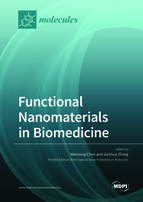Functional Nanomaterials in Biomedicine
A special issue of Molecules (ISSN 1420-3049). This special issue belongs to the section "Nanochemistry".
Deadline for manuscript submissions: closed (31 July 2022) | Viewed by 33754
Special Issue Editors
Interests: nanomedicine; functional nanomaterials; cancer therapy; nanocatalysis
Interests: design; functionalization and fabrication of polymers and polymer-based nanomaterials for various applications in biomedical fields and petroleum industry
Special Issues, Collections and Topics in MDPI journals
Special Issue Information
Dear Colleagues,
Today, various nanomaterials are designed and prepared for nanomedicine, such as polymer nanodrugs, metal–organic frameworks, inorganic nanocrystals, and organic semiconducting nanomaterials. The applications of nanomaterials overcome several limitations of traditional molecular drugs, including short circulation time, serious side effects, and low bioavailability. Accordingly, the great success of nanotechnology promotes a tremendous revolution in biomedical field. Various therapeutic nanoplatforms have been developed with therapeutic functions and intelligent properties. For example, semiconducting nanomaterials are found with responsiveness to external stimuli, such as light and ultrasound. Moreover, many nanocatalysts with enzymatic activity have also been designed as artificial enzymes for catalytic therapy. Recently, some functional nanomaterials have exhibited modulating activity to the immune system and thus activate adaptive immunity. Based on all the abovementioned features, functional nanomaterials have been widely applied for the treatment of various diseases, such as cancer, bacterial infection, diabetes, inflammation, and neurodegenerative disorder.
However, the development of nanomedicine suffers from several challenges prior to their clinical applications. For instance, disease detection in an early stage is a critical challenge for nanomedicine. It is difficult to detect disease markers (e.g., proteins, genes, or cancer circulating cells), so nanoprobes with high sensitivity and selectivity are required. Moreover, to overcome drug resistance, it is highly desirable to develop functional nanomedicines with the combination of multiple therapeutic modalities, such as chemotherapy, photothermal therapy, photodynamic therapy, chemodynamic therapy, radiotherapy, starving therapy, and immunotherapy. Additionally, the stability and degradability of most nanomedicines in biofluids should be carefully evaluated before their administration to humans.
The main aims of the Special Issue on "Functional Nanomaterials in Biomedicine" is to be an open forum where researchers may share their investigations and findings in this promising field. Contributions to this issue, both in the form of original research or review articles, are particularly welcome.
Prof. Wansong Chen
Prof. Dr. Jianhua Zhang
Guest Editors
Manuscript Submission Information
Manuscripts should be submitted online at www.mdpi.com by registering and logging in to this website. Once you are registered, click here to go to the submission form. Manuscripts can be submitted until the deadline. All submissions that pass pre-check are peer-reviewed. Accepted papers will be published continuously in the journal (as soon as accepted) and will be listed together on the special issue website. Research articles, review articles as well as short communications are invited. For planned papers, a title and short abstract (about 100 words) can be sent to the Editorial Office for announcement on this website.
Submitted manuscripts should not have been published previously, nor be under consideration for publication elsewhere (except conference proceedings papers). All manuscripts are thoroughly refereed through a single-blind peer-review process. A guide for authors and other relevant information for submission of manuscripts is available on the Instructions for Authors page. Molecules is an international peer-reviewed open access semimonthly journal published by MDPI.
Please visit the Instructions for Authors page before submitting a manuscript. The Article Processing Charge (APC) for publication in this open access journal is 2700 CHF (Swiss Francs). Submitted papers should be well formatted and use good English. Authors may use MDPI's English editing service prior to publication or during author revisions.
Keywords
- stimuli-sensitive nanomedicines
- advanced targeting delivery
- controlled drug release
- theranostic nanomedicines
- functional polymeric nanoparticles
- biosensing and diagnostics
- biomimetic nanomedicines
- catalytic therapy








